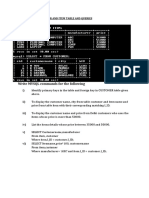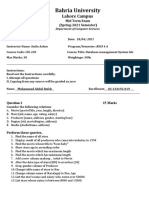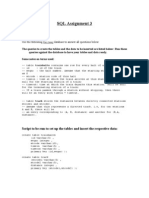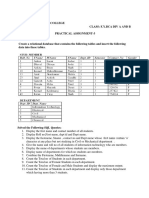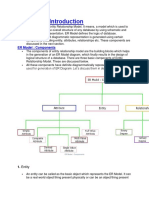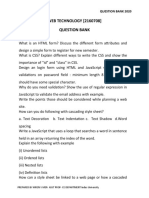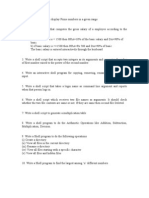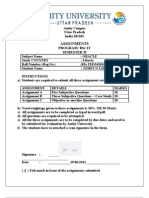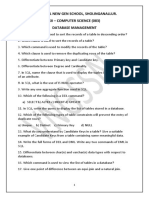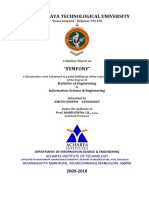DDL &DML Practice SQL
Uploaded by
karthik1998DDL &DML Practice SQL
Uploaded by
karthik1998DDL EXERCISE
Commands: CREATE TABLE, ALTER TABLE, DROP, TRUNCATE
Consider the following relations (schemas) for a database that keeps track of student enrollment
in courses and the books referenced for each course.
STUDENT (ROLLNO, NAME, DEPARTMENTCODE, DOB, EMAIL, ADDRESS)
COURSE (CCODE, CNAME, DEPARTMENTCODE)
ENROLL (ROLLNO, COURSECODE, SEMESTER, GRADE)
TEXTBOOK (COURSECODE, SEMESTER, BOOK_ISBN)
BOOKDETAILS (BOOK_ISBN, TITLE, PUBLISHER, AUTHOR)
(1) Identify the required key constraints and create tables for the above mentioned schemas.
(2) Add a column named “PRICE” in BOOKDETAILS.
(3) Add a check constraint in GRADE column in ENROLL table to restrict that it can hold
only (O, A+, A, B+, B, RA).
(4) Drop the column ADDRESS in STUDENT table.
(5) What happens if the column ADDRESS in STUDENT table is dropped with “Cascade”
option?
(6) Create tables DEPARTMENT and BRANCH with the following schema
DEPARTMENT (DCODE, DNAME, DLOCATION, BRANCHCODE)
BRANCH (BRANCHCODE, BNAME)
(7) Add a foreign key constraint to the STUDENT table for linking it with DEPARTMENT
table. Give a name to your foreign key.
(8) Difference between DROP table and TRUNCATE table
(9) Add a NOT NULL constraint to the AUTHOR column in BOOKDETAILS table.
(10) Add columns to BOOKDETAILS table named PUBLISHED_YEAR, EDITION and
make it NOT NULL.
(11) Display the constraint type and constraint name included in the table STUDENT.
(12) Modify the datatype (or size) of the CNAME column in COURSE TABLE.
(13) Rename the table BRANCH as BRANCH_DETAILS.
(14) Rename the column DOB in STUDENT table as BIRTHDATE.
(15) Drop BRANCH_DETAILS table with “Cascade” option.
DML Exercise
Commands: INSERT, INSERT ALL, DELETE, UPDATE
(1) Insert 10 records in each table without violating constraints using single row insert
(INSERT) and multiple row insert (INSERT ALL) command.
(2) Use substitution variable (&) in INSERT to read value for a variable.
(3) What is the difference between & and &&.
(4) Create a table called HIGHBOOK_PRICE with two columns (ISBN, Price). Insert the
records in the HIGHBOOK_PRICE table with the following details from BOOKDETAILS
table: “books whose price is greater than 3000”.
(5) Increase the price of all the books by 100, which were published after the year 2005.
(6) Delete all the first edition book details from the BOOKDETAILS table.
(7) Why we need of Commit Statement in DML commands?
(8) Modify the email id of a student whose roll number is specified by the user.
You might also like
- (Exercise On Retrieving Records From The Table)100% (1)(Exercise On Retrieving Records From The Table)19 pages
- Class 11 Asseration Reason Informatics Practices Chp 7 (2024-25)No ratings yetClass 11 Asseration Reason Informatics Practices Chp 7 (2024-25)26 pages
- MySQL Subquery - Exercises, Practice, SolutionNo ratings yetMySQL Subquery - Exercises, Practice, Solution58 pages
- Important SQL Practice Questions With AnswersNo ratings yetImportant SQL Practice Questions With Answers7 pages
- Rdbms and SQL: Name:Ibrahim Sameer V S REG NO:17BCA0062100% (1)Rdbms and SQL: Name:Ibrahim Sameer V S REG NO:17BCA006233 pages
- Anna University OOPS Question Bank Unit 2No ratings yetAnna University OOPS Question Bank Unit 26 pages
- Part A: SQL Programming: DBMS Lab Manual-2019-20No ratings yetPart A: SQL Programming: DBMS Lab Manual-2019-2033 pages
- Question 1: Suppose You Are Given The Following Requirements For A SimpleNo ratings yetQuestion 1: Suppose You Are Given The Following Requirements For A Simple13 pages
- Unit 1 Introduction To Database: CharacteristicsNo ratings yetUnit 1 Introduction To Database: Characteristics79 pages
- Software Requirements Specification For Library Management SystemNo ratings yetSoftware Requirements Specification For Library Management System9 pages
- SQL Express Scripting From Wincc AdvancedNo ratings yetSQL Express Scripting From Wincc Advanced12 pages
- Uzima Borehole and Drilling Management SystemNo ratings yetUzima Borehole and Drilling Management System32 pages
- Database Analysis and Design Assignment 01No ratings yetDatabase Analysis and Design Assignment 0112 pages

